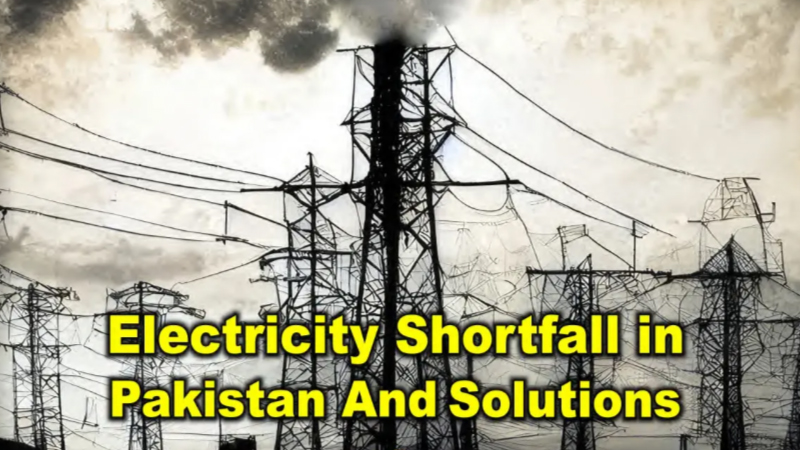The basic issue in our country regarding the fulfillment of energy requirements has always been a primary and persistent problem. We can see that the energy crisis halts the progress of our country. Whenever there has been a demand for mutual cooperation between two countries or any commercial agreements, the energy crisis has proved to be a barrier to the fulfillment of those projects. Likewise, due to the energy crisis in Pakistan, we have also noticed that the global standing of our country has fallen in digital marketing. Like other progressive countries, Pakistan is trying to put forward its efforts in the field of IT, but unfortunately, we have failed to prove ourselves as a well-developed and fully equipped country regarding technology. Due to the shortfall in electricity, our country has been lacking in competing with other countries.
Electricity, as a source of energy, is an essential input in the production process. It is impossible to achieve sustainable, high economic growth without a high-quality, uninterrupted power supply. Pakistan is a case study on the consequences of energy shortages, which have contributed to the country's sluggish GDP growth, industrial stagnation, slow employment generation, a large negative impact on the federal budget, and distress for everyday household customers. With Pakistan's urban population growing rapidly, the demand for electricity is increasing. At the same time, traditional fuel sources are being consumed less. However, the demand has far outpaced the supply, leading to frequent power outages, especially in rural areas.
It's crucial to address this issue and ensure a reliable and uninterrupted power supply for all areas. Weak governance, mismanagement in the energy sector, and inadequate investment in electricity generation capacity have resulted in a significant shortfall of 32% in electricity supply compared to demand. The difference between Pakistan's energy demand and supply is almost 3000 MW (undergoing an acute energy crisis) [1], which is tackled through a load shedding process with average outages of 6–12 hours a day. Hence, research is being carried out to look for the optimal model for choosing the ideal renewable energy generation sources in Pakistan. Over the past ten years, Pakistan has been undergoing the most severe energy crisis, and almost 145 million people do not have access to electricity, particularly in non-urban areas. Power outages last for 12–14 hours a day in some areas, and this is the primary cause of the decline in the country's economic growth [2,3].
It's crucial to address these issues and implement effective measures to bridge the gap and ensure a reliable and sufficient supply of electricity for the country. The ongoing reforms in the energy sector to privatize state-owned distribution companies are indeed happening, but at a slow pace. This slow progress has made it challenging to bridge the gap between electricity supply and demand and put an end to the ongoing blackouts. These blackouts continue to have negative consequences on Pakistan's economy, social sector, and overall stability. It's crucial to expedite the reforms and ensure a more stable and reliable electricity supply for the country's development. Climate change is a huge hazard for many developing economies, including Pakistan. A high proportion of Pakistanis perish because of the impact of climate change. For example, during the Kashmir earthquake in 2005, 80,000 people died, and around 100,000 people were critically injured. Three million people lost their homes, and Pakistan's economy suffered a loss of 6.2 billion USD, making up 1.1% of the country's overall GDP [4].
Lately, the United States Government, along with the World Bank, has assisted the Government of Pakistan with regional solar energy and wind resource mapping research [5]. The solar energy mapping research [4], carried out by the US National Renewable Energy Laboratory (NREL) along with the German Aerospace Center Institute (DLR), measured that Pakistan's solar power capacity is around 1600 GW [6], with a few western regions of the country possessing capacity comparable to the world's maximum MENA region [7]. These studies have assessed around 65–70 well-kept weather terminals to ensure the veracity of findings from the regional basic frameworks [6]. Under these circumstances, hydrogen energy is the optimum choice to enhance the country's economy and decrease the energy dilemma, as Pakistan has adequate hydrogen energy resources to fulfill energy requirements in multiple sectors, including agriculture, transport, and electricity. Several studies [8] have proposed applications regarding renewable energy sources for hydrogen generation through technology and innovation. For instance, Wang et al. [9] stated that sustainable and natural energy sources, such as solar, biomass, wastages, geothermal energy, and wind energy, can be used for renewable hydrogen energy.
In light of the numerous advantages associated with RE-based hydrogen energy, including reduced environmental effects, affordable electricity production, and increased technical and societal benefits, policymakers find it challenging to choose the most suitable electricity sources among renewable energies (such as biomass, solar, wind, municipal solid waste, geothermal, and small hydro). In this context, Afghan et al. [10] devised a feasibility indexing performance-based variable model by considering the market, social, and economic aspects.
Investigational studies [11] have elaborated that electrolysis is a financially feasible and eco-friendly approach for the generation of renewable hydrogen and for the management of wind energy. This is in consideration of the long-term impact of the strategy for substituting a fossil fuel economy with a renewable economy to improve the potential
combination of national power production. The five factors involved in the investigation are CO2 emission, feedstock, operational and management costs, capital cost, and production cost. Pakistan possesses substantial wind power energy sources and significant energy production capacity for hydrogen generation. It is noted that Pakistan has excellent wind speeds in some regions, which can be used for wind-based electricity power generation. Wind speeds are the best in the southern coastal regions, with an average of 5.6 m/s at 10 m mast height [4]. Solar energy is also a cheaper and cost-effective source of electricity.
In a nutshell, there are ways to generate cost-effective and eco-friendly energy, but the issue is to manage it with honest policies and diligence. Power crises are not insurmountable, but solutions require commitment and integrity from leaders.
References:
1. Iram, R., Anser, M. K., Awan, R. U., Ali, A., Abbas, Q., & Chaudhry, I. S. (2021). Prioritization of renewable solar energy to prevent energy insecurity: an integrated role. The Singapore Economic Review, 66(02), 391-412.
2. Anser, M. K., Mohsin, M., Abbas, Q., & Chaudhry, I. S. (2020). Assessing the integration of solar power projects: SWOT-based AHP–F-TOPSIS case study of Turkey. Environmental Science and Pollution Research, 27, 31737-31749.
3. Mohsin, M., Zhang, J., Saidur, R., Sun, H., & Sait, S. M. (2019). Economic assessment and ranking of wind power potential using fuzzy-TOPSIS approach. Environmental Science and Pollution Research, 26, 22494-22511.
4. Iqbal, W., Yumei, H., Abbas, Q., Hafeez, M., Mohsin, M., Fatima, A., ... & Sohail, N. (2019). Assessment of wind energy potential for the production of renewable hydrogen in Sindh Province of Pakistan. Processes, 7(4), 196.
5. Iram, R., Zhang, J., Erdogan, S., Abbas, Q., & Mohsin, M. (2020). Economics of energy and environmental efficiency: evidence from OECD countries. Environmental Science and Pollution Research, 27, 3858-3870.
6. Iqbal, W., Altalbe, A., Fatima, A., Ali, A., & Hou, Y. (2019). A DEA approach for assessing the energy, environmental and economic performance of top 20 industrial countries. Processes, 7(12), 902.
7. Sun, H. P., Tariq, G., Haris, M., & Mohsin, M. (2019). Evaluating the environmental effects of economic openness: evidence from SAARC countries. Environmental Science and Pollution Research, 26, 24542-24551.
8. Yumei, H., Iqbal, W., Nurunnabi, M., Abbas, M., Jingde, W., & Chaudhry, I. S. (2021). Nexus between corporate social responsibility and firm’s perceived performance: evidence from SME sector of developing economies. Environmental Science and Pollution Research, 28, 2132-2145.
9. Mohsin, M., Abbas, Q., Zhang, J., Ikram, M., & Iqbal, N. (2019). Integrated effect of energy consumption, economic development, and population growth on CO 2 based environmental degradation: a case of transport sector. Environmental Science and Pollution Research, 26, 32824-32835.
10. Afgan, N. H., Veziroglu, A., & Carvalho, M. G. (2007). Multi-criteria evaluation of hydrogen system options. International Journal of Hydrogen Energy, 32(15), 3183-3193.
11. Chien, F., Kamran, H. W., Albashar, G., & Iqbal, W. (2021). Dynamic planning, conversion, and management strategy of different renewable energy sources: a sustainable solution for severe energy crises in emerging economies. International Journal of Hydrogen Energy, 46(11), 7745-7758.


